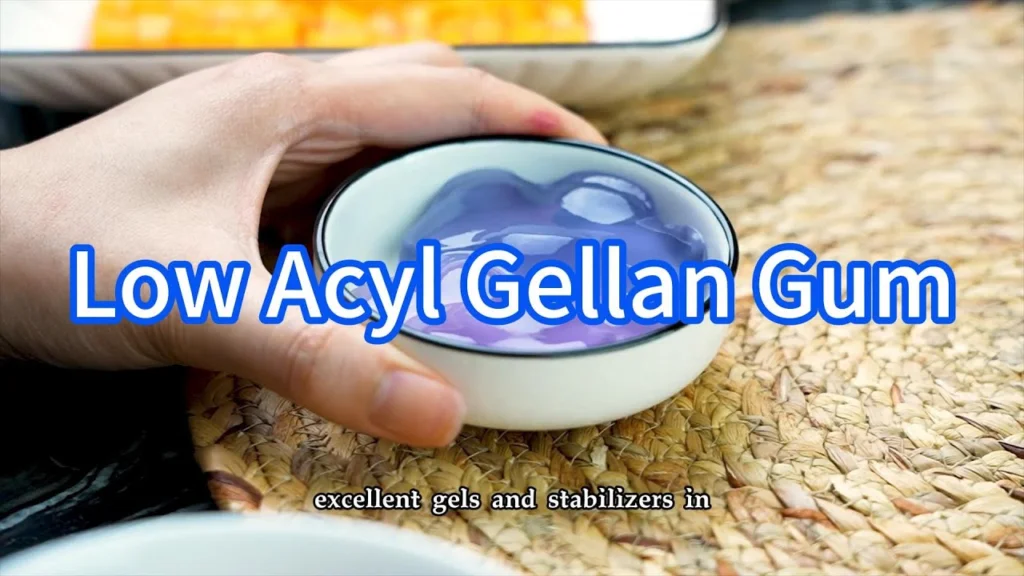L'utilisation de la gomme gellane à faible teneur en acyle dans les produits alimentaires à pH acide est un voyage fascinant dans le monde de la science alimentaire. Cet ingrédient unique, connu pour ses propriétés gélifiantes exceptionnelles, joue un rôle crucial dans l'amélioration de la texture et de la stabilité de diverses formulations alimentaires. Voyons plus en détail comment la gomme gellane à faible teneur en acyle de Shine opère sa magie dans les environnements acides.

La gomme gellane à faible teneur en acyle se distingue par ses remarquables propriétés gélifiantes, en particulier dans des conditions acides. Lorsqu'il est exposé à des niveaux de pH faibles, cet ingrédient se transforme en gels solides et élastiques, ajoutant de l'épaisseur et de la structure aux produits alimentaires. Imaginez-la comme l'architecte de votre dessert préféré, créant une base solide qui maintient le tout ensemble.
Malgré les défis posés par les environnements acides, la gomme gellane à faible teneur en acyle de Shine reste stable et fiable. Cette stabilité assure le maintien des propriétés gélifiantes, garantissant une texture et une qualité constantes dans les formulations alimentaires acides. C'est comme avoir un compagnon inébranlable dans la cuisine, toujours prêt à fournir des résultats exceptionnels.
En ce qui concerne les applications, la gomme gellane faiblement acylée brille de tous ses feux dans les produits laitiers et à base de plantes. Qu'il soit utilisé dans les substituts de produits laitiers, les préparations à base de fruits ou d'autres produits alimentaires acides, cet ingrédient polyvalent apporte texture, suspension et stabilité. C'est l'ingrédient secret qui élève vos friandises préférées à un tout autre niveau.
Il est essentiel de comprendre comment la gomme gellane à faible teneur en acyle de Shine interagit avec d'autres ingrédients pour exploiter pleinement son potentiel dans les environnements acides. En maîtrisant ces interactions, les fabricants de produits alimentaires peuvent optimiser la fonctionnalité de cet ingrédient et obtenir les caractéristiques souhaitées dans leurs produits. C'est comme orchestrer une symphonie de saveurs, où chaque composant joue un rôle crucial dans la création d'un mélange harmonieux.
En matière de réglementation et d'étiquetage, la transparence est primordiale. Les fabricants de produits alimentaires qui utilisent de la gomme gellane à faible teneur en acyle doivent respecter les réglementations et étiqueter leurs produits avec précision. Cela permet non seulement d'assurer la conformité, mais aussi d'instaurer un climat de confiance avec les consommateurs, en démontrant un engagement de qualité et d'intégrité dans les produits alimentaires à pH acide. Il s'agit de créer un dialogue transparent avec les clients, en leur faisant savoir que ce qu'ils voient est vraiment ce qu'ils obtiennent.
Propriétés gélifiantes de la gomme gellane à faible teneur en acyle
La gomme gellane à faible teneur en acyle présente des propriétés gélifiantes remarquables qui en font un ingrédient recherché dans le domaine des produits alimentaires à pH acide. Lorsqu'elle est soumise à des conditions acides, cette gomme gellane spécialisée montre sa capacité à former des gels robustes et flexibles, servant ainsi de composant polyvalent pour l'épaississement et la structuration de divers produits alimentaires.

L'une des principales caractéristiques de la gomme gellane à faible teneur en acyle est sa capacité à créer des gels stables dans les environnements acides. Malgré les faibles niveaux de pH, cette gomme gellane conserve son intégrité structurelle et ses capacités de gélification, ce qui garantit la constance et la fiabilité de la texture et de la qualité des formulations alimentaires acides.
En ce qui concerne les applications, la gomme gellane à faible teneur en acyle est largement utilisée dans les produits laitiers et à base de plantes, offrant un soutien inestimable pour obtenir les textures, les suspensions et la stabilité souhaitées. Qu'il s'agisse d'alternatives laitières, de préparations à base de fruits ou d'autres créations alimentaires acides, cette gomme gellane joue un rôle essentiel dans l'amélioration de l'expérience globale du produit.
En outre, il est essentiel de comprendre comment la gomme gellane à faible teneur en acyle interagit avec d'autres ingrédients en milieu acide pour optimiser ses performances et obtenir les caractéristiques souhaitées dans les produits alimentaires. En comprenant ces interactions, les fabricants peuvent exploiter tout le potentiel de cet agent gélifiant pour répondre à des exigences de formulation spécifiques.
D'un point de vue réglementaire, il est essentiel que les fabricants de produits alimentaires respectent les directives de l'industrie et étiquettent avec précision les produits contenant de la gomme gellane à faible teneur en acyle. En veillant au respect des réglementations et en fournissant un étiquetage transparent, les marques peuvent inspirer confiance aux consommateurs quant à l'utilisation de cet ingrédient dans les produits alimentaires à pH acide.
Stabilité en milieu acide
Lorsqu'il s'agit de la stabilité de la gomme gellane faiblement acylée dans les environnements acides, les performances de cet ingrédient sont vraiment remarquables. Malgré les faibles niveaux de pH difficiles que l'on trouve couramment dans les produits alimentaires acides, la gomme gellane faiblement acylée résiste, conservant son intégrité et sa fonctionnalité. Cette stabilité remarquable garantit que les fabricants de produits alimentaires peuvent compter sur cet agent gélifiant pour obtenir des résultats constants, quelle que soit l'acidité de la formulation.

Imaginez un monde où vos créations alimentaires acides n'auraient jamais à se soucier de problèmes de texture ou de qualité. La gomme gellane à faible teneur en acyle fait de ce rêve une réalité en résistant aux conditions difficiles des environnements acides sans compromettre ses propriétés gélifiantes. Cette résilience change la donne pour les producteurs de denrées alimentaires qui cherchent à créer des produits innovants et fiables qui se démarquent sur le marché.
En outre, la stabilité de la gomme gellane à faible teneur en acyle ouvre un monde de possibilités pour la formulation des aliments. Qu'il s'agisse d'alternatives laitières, de produits à base de fruits ou d'autres délices acides, cet ingrédient joue un rôle crucial en apportant la texture, la suspension et la stabilité globale souhaitées. Sa capacité à se développer dans des environnements acides la distingue des autres épaississants et gélifiants, ce qui en fait un choix de premier ordre pour une large gamme d'applications.
Si l'on considère l'interaction de la gomme gellane faiblement acylée avec d'autres ingrédients dans des environnements acides, sa stabilité devient encore plus essentielle. Le mélange harmonieux de cet agent gélifiant avec les différents composants d'une formulation est essentiel pour obtenir l'équilibre parfait de la texture et de la sensation en bouche. Comprendre comment la gomme gellane faiblement acylée se comporte avec différents ingrédients est le secret pour libérer tout son potentiel et créer des produits alimentaires exceptionnels à pH acide.
Dans le domaine des normes réglementaires et de l'étiquetage des produits, la stabilité de la gomme gellane à faible teneur en acyle joue un rôle essentiel. Les fabricants de produits alimentaires doivent respecter des directives strictes et étiqueter leurs produits avec précision afin de préserver la transparence et la confiance des consommateurs. En utilisant cet ingrédient fiable dans les produits alimentaires à pH acide, les marques peuvent s'assurer que leurs produits répondent aux exigences réglementaires nécessaires tout en garantissant la qualité et la cohérence.
Applications dans les produits laitiers et végétaux
Lorsqu'il s'agit d'applications dans les produits laitiers et à base de plantes, la gomme gellane à faible teneur en acyle s'impose comme un ingrédient remarquable. Ses propriétés gélifiantes uniques et sa stabilité dans les environnements acides en font un choix de premier ordre pour les fabricants de produits alimentaires qui cherchent à améliorer la texture et la qualité de leurs produits. Qu'il s'agisse d'alternatives laitières, de préparations à base de fruits ou d'autres formulations alimentaires acides, la gomme gellane faiblement acylée joue un rôle crucial en apportant la texture, la suspension et la stabilité souhaitées.

Imaginez un yaourt crémeux à base de plantes qui conserve une texture lisse et homogène tout au long de sa durée de conservation : c'est la magie de la gomme gellane à faible teneur en acyle qui opère. En formant des gels solides et élastiques dans des conditions acides, cet ingrédient garantit que les produits laitiers et à base de plantes ne sont pas seulement attrayants, mais qu'ils offrent également une délicieuse sensation en bouche qui incite les consommateurs à en redemander.
En outre, la polyvalence de la gomme gellane faiblement acylée offre des possibilités infinies en matière de développement de produits. De l'épaississement des crèmes glacées sans produits laitiers à la stabilisation des fourrages acides aux fruits, les applications de cet ingrédient sont aussi diverses que l'industrie alimentaire elle-même. Les fabricants et les fournisseurs de gomme gellane reconnaissent la valeur de cet ingrédient et offrent aux innovateurs alimentaires une solution fiable pour obtenir une texture et une consistance parfaites dans leurs créations.
Imaginez une boisson rafraîchissante à base de plantes avec des particules de fruits en suspension qui ne se déposent pas au fond - c'est le résultat de la magie de la gomme gellane à faible teneur en acyle. Sa capacité à interagir harmonieusement avec d'autres ingrédients dans des environnements acides garantit que le produit final conserve son intégrité et son attrait visuel, créant ainsi une expérience sensorielle qui captive les consommateurs de la première à la dernière gorgée.
Les fabricants de produits alimentaires qui cherchent à garder une longueur d'avance comprennent l'importance d'incorporer des ingrédients de haute qualité tels que la gomme gellane à faible teneur en acyle dans leurs formulations. Non seulement elle répond aux exigences des consommateurs modernes qui recherchent des alternatives à base de plantes et des produits de marque propre, mais elle ouvre également la voie à des possibilités culinaires infinies qui améliorent l'expérience globale de la consommation.
Interaction avec d'autres ingrédients
En ce qui concerne la gomme gellane faiblement acylée, elle démontre sa polyvalence et sa compatibilité dans les formulations alimentaires acides. Cet hydrocolloïde unique a la capacité d'interagir harmonieusement avec une large gamme de composants, contribuant à la texture globale et à la stabilité du produit final. Qu'il s'agisse d'alternatives laitières, de préparations à base de fruits ou de produits à base de plantes, la gomme gellane faiblement acylée de Briller s'intègre parfaitement à divers ingrédients pour améliorer l'expérience sensorielle des consommateurs.

L'un des principaux aspects de l'utilisation de la gomme gellane à faible teneur en acyle dans les produits alimentaires à pH acide est son pouvoir de rétention. effets synergiques avec d'autres hydrocolloïdes et stabilisants. En l'associant à des ingrédients tels que la pectine ou le carraghénane, les fabricants de produits alimentaires peuvent obtenir un effet synergique qui améliore les propriétés gélifiantes et les performances globales du produit. Cette combinaison stratégique permet non seulement d'améliorer la texture, mais aussi de garantir une meilleure suspension et une meilleure sensation en bouche, répondant ainsi aux normes élevées fixées par les consommateurs exigeants.
En outre, le interactions L'interaction entre la gomme gellane faiblement acylée et d'autres composants joue un rôle crucial dans la détermination des caractéristiques du produit final. Il est essentiel de comprendre comment cet hydrocolloïde interagit avec les protéines, les sucres et les acides pour formuler des produits alimentaires acides réussis. En équilibrant soigneusement ces interactions, les fabricants peuvent obtenir la viscosité, la stabilité et les attributs sensoriels souhaités, créant ainsi des produits qui se démarquent sur le marché.
En outre, le la compatibilité La combinaison de la gomme gellane à faible teneur en acyle avec une variété d'ingrédients permet des formulations innovantes et une différenciation des produits. Qu'il s'agisse de créer une texture crémeuse dans les produits laitiers ou d'améliorer la sensation en bouche des produits à base de fruits, cet ingrédient polyvalent offre des possibilités infinies de créativité culinaire. Avec le soutien de Gomme gellane Fabricants et Fournisseurs de gomme gellaneLes développeurs de produits alimentaires peuvent ainsi explorer de nouvelles combinaisons et applications pour répondre à l'évolution de la demande des consommateurs.
En conclusion, il est essentiel de tirer parti des avantages de la gomme gellane à faible teneur en acyle dans les produits alimentaires à pH acide. En comprenant sa compatibilité, ses effets synergiques et ses applications potentielles, les fabricants de produits alimentaires peuvent exploiter tout le potentiel de cet hydrocolloïde pour créer des formulations alimentaires innovantes et de haute qualité. Avec la bonne combinaison d'ingrédients et l'expertise de BrillerLes possibilités d'excellence culinaire sont illimitées.
Considérations réglementaires et étiquetage
Lorsqu'il s'agit d'incorporer gomme gellane à faible teneur en acyle dans les produits alimentaires à pH acide, il existe d'importantes considérations réglementaires que les fabricants de produits alimentaires doivent prendre en compte. Le respect des réglementations alimentaires est essentiel pour garantir la sécurité et la transparence des produits contenant cet ingrédient polyvalent.

Les organismes de réglementation alimentaire du monde entier fixent des normes pour l'utilisation d'additifs tels que l'huile d'olive, l'huile d'olive et l'huile de palme. gomme gellane afin de préserver la santé des consommateurs et d'empêcher les pratiques d'étiquetage trompeuses. Les fabricants doivent respecter ces lignes directrices afin de préserver l'intégrité de leurs produits et la confiance des consommateurs.
Correct l'étiquetage de produits alimentaires contenant gomme gellane à faible teneur en acyle est essentiel pour fournir des informations précises aux consommateurs. Un étiquetage clair et concis aide les individus à faire des choix éclairés sur les produits qu'ils achètent et consomment.
En établissant une liste précise gomme gellane en tant qu'ingrédient sur les étiquettes des produits, les fabricants démontrent leur engagement en matière de transparence et de respect des normes réglementaires. Cette transparence permet d'instaurer un climat de confiance avec les consommateurs et de renforcer la réputation de la marque. Brilleren tant que producteur responsable de produits alimentaires de haute qualité.
En outre, la compréhension de la paysage réglementaire entourant gomme gellane permet aux fabricants de produits alimentaires de naviguer efficacement sur le marché et d'éviter les problèmes juridiques potentiels. En restant informé des changements et des mises à jour réglementaires, les produits restent conformes et compétitifs dans l'industrie.
En résumé, considérations réglementaires et précis l'étiquetage sont des aspects à part entière de l'intégration des gomme gellane à faible teneur en acyle dans les produits alimentaires à pH acide. En donnant la priorité à la conformité et à la transparence, les fabricants de produits alimentaires peuvent renforcer la confiance des consommateurs et s'imposer comme des fournisseurs réputés de produits alimentaires innovants et sûrs.
Questions fréquemment posées
- Qu'est-ce que la gomme gellane à faible teneur en acyle ?La gomme gellane faiblement acylée est un hydrocolloïde dérivé de la fermentation bactérienne qui est couramment utilisé dans les produits alimentaires pour ses propriétés gélifiantes et stabilisantes, en particulier dans les environnements acides.
- Comment la gomme gellane à faible teneur en acyle fonctionne-t-elle dans les produits alimentaires à pH acide ?La gomme gellane à faible teneur en acyle présente d'excellentes propriétés gélifiantes dans des conditions acides, formant des gels solides et élastiques qui contribuent à épaissir et à structurer les produits alimentaires tout en préservant leur stabilité et leur texture.
- Quelles sont les principales applications de la gomme gellane à faible teneur en acyle ?La gomme gellane à faible teneur en acyle est largement utilisée dans les produits laitiers, les préparations à base de fruits et d'autres produits alimentaires acides pour améliorer la texture, la suspension et la stabilité grâce à son comportement gélifiant unique.
- Quelle est l'importance de comprendre l'interaction de la gomme gellane à faible teneur en acyle avec d'autres ingrédients ?Il est essentiel de comprendre comment la gomme gellane à faible teneur en acyle interagit avec d'autres composants dans des environnements acides pour que les fabricants de produits alimentaires puissent optimiser sa fonctionnalité et obtenir les caractéristiques souhaitées dans leurs produits.
- Quelles sont les considérations réglementaires à prendre en compte lors de l'utilisation de la gomme gellane à faible teneur en acyle ?Les fabricants de produits alimentaires doivent respecter les directives réglementaires et étiqueter avec précision les produits contenant de la gomme gellane à faible teneur en acyle afin de garantir la transparence et de renforcer la confiance des consommateurs dans les produits alimentaires à pH acide.
